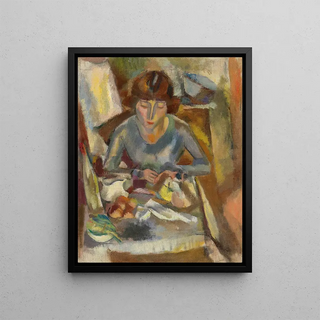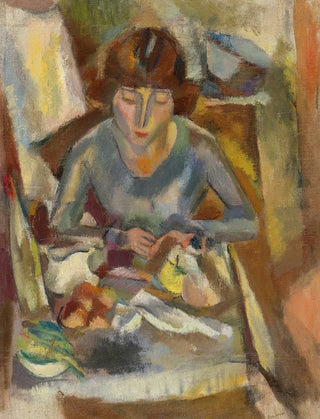Art print | Hermine David in front of the table - Jules Pascin


View from behind

Frame (optional)
In the world of art, some works manage to capture not only the eye but also the soul. "Hermine David devant la table" by Jules Pascin is a perfect example. This canvas, vibrant with life and color, immerses us in the intimacy of a suspended moment, where the gaze of the model, Hermine David, seems to invite us to share her universe. Through this artwork, Pascin explores themes of beauty, melancholy, and contemplation, while offering us a window into his era, the early 20th century, marked by profound social and artistic changes.
Style and uniqueness of the work
Jules Pascin's style is undeniably characterized by a unique approach that combines various influences, ranging from Fauvism to Expressionism. In "Hermine David devant la table," the brushstrokes are both delicate and assertive, creating an intimate atmosphere. The warm colors and the play of shadow and light give the scene striking depth. The composition, centered on the female figure, evokes a certain softness while revealing underlying tension, as if each element of the work was charged with a personal story. This duality between apparent lightness and latent melancholy is one of Pascin's hallmarks, who knows how to capture the very essence of his subjects with rare sensitivity.
The artist and his influence
Jules Pascin, born in Bulgaria and raised in an artistic environment, managed to establish himself on the Parisian scene of the 1900s. His encounters with emblematic figures of modern art, such as Modigliani and Soutine, enriched his journey and influenced his style. Pascin is often considered a precursor of the Expressionist movement, his artistic vision being deeply rooted in the realities of everyday life. Through his work, he depicts not only the beauty of women but also the struggles and aspirations of his time. "Hermine David devant la table" exemplifies this quest for authenticity and truth, where each brushstroke bears witness to a deep understanding of the human being. His legacy

Matte finish

View from behind

Frame (optional)
In the world of art, some works manage to capture not only the eye but also the soul. "Hermine David devant la table" by Jules Pascin is a perfect example. This canvas, vibrant with life and color, immerses us in the intimacy of a suspended moment, where the gaze of the model, Hermine David, seems to invite us to share her universe. Through this artwork, Pascin explores themes of beauty, melancholy, and contemplation, while offering us a window into his era, the early 20th century, marked by profound social and artistic changes.
Style and uniqueness of the work
Jules Pascin's style is undeniably characterized by a unique approach that combines various influences, ranging from Fauvism to Expressionism. In "Hermine David devant la table," the brushstrokes are both delicate and assertive, creating an intimate atmosphere. The warm colors and the play of shadow and light give the scene striking depth. The composition, centered on the female figure, evokes a certain softness while revealing underlying tension, as if each element of the work was charged with a personal story. This duality between apparent lightness and latent melancholy is one of Pascin's hallmarks, who knows how to capture the very essence of his subjects with rare sensitivity.
The artist and his influence
Jules Pascin, born in Bulgaria and raised in an artistic environment, managed to establish himself on the Parisian scene of the 1900s. His encounters with emblematic figures of modern art, such as Modigliani and Soutine, enriched his journey and influenced his style. Pascin is often considered a precursor of the Expressionist movement, his artistic vision being deeply rooted in the realities of everyday life. Through his work, he depicts not only the beauty of women but also the struggles and aspirations of his time. "Hermine David devant la table" exemplifies this quest for authenticity and truth, where each brushstroke bears witness to a deep understanding of the human being. His legacy






